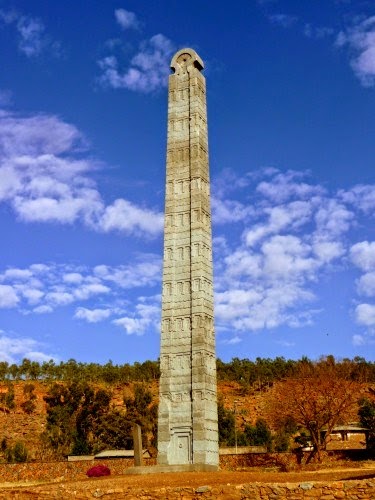An observation by the Britsh Archaeologist Theodore Bent
after a visit to Aksum in 1893.
Egypt's pyramids were like great advertboards announcing to
the world the authority, power and prominence of the ruling families. And
probably the Aksum's astounding stelae had the same purpose.
From among the many that you see in Aksum, particularly six
of the stelae were carved in the likeness of the multistoried buildings
complete with windows, doors and sometimes door handles and locks. The design
and carvings follow the traditional Aksumite Architectural style.
In 1996 a broken plate that perfectly matched the rivet
holes at the top of the stelae were excavated, strengthening the idea that in
the former times ,metal plates, perhaps in the form of a crescent moon and
disc, are thought to have been engrossed to the top of the stelae both at the
front and back. The excavated plates bore the effigy of a face perhaps that of
the ruler to whom the stele was dedicated.
At the base of the stelae you would find a stone platform.
The platform is believed to have served as an altar where sacrificial offerings
were held.
Among the mystery about these stelae are; why were they
designed in this way? How were they transported (because, from among them, some
weigh about 500 tones)? How were they erected? Archaeologists believe that the
earthly forces of elephants, rollers and winches were probably applied.
The Northern stelae Park
The Northern stelae Park is situated in the North Eastern
part of the town. It is the most important stelae field in Aksum because it
contains over 120 stelae which range between 1 meter and 30 meters in height.
The great stele, which is believed to be the largest one
block of stone that humans have ever attempted to erect, measures 33 meters. It
has now fallen down probably in the process of resection or as a result of war.
King Ezana’s stele (24 meter in height) is now the tallest
still standing. The British traveler by the name Henry Salt who visited it 1805
says “the most admirable and perfect monument of its kind.”
Among the various other stelae, the one that measure 9
meters and lies on the ground 200m to the North of King ezana’s stele, has got
a unique decoration. Near the top of the stele a small house like object is
carved in relief, formed by a rectangle surmounted by a triangle and this is
claimed by some to be proof of Aksum’s claim to house the original Ark of the
Covenant
The Looted Obelisk
The second-largest Stele, 25 m high, was shipped to Italy in
1937 during the Ethio-Italy war on the personal orders of Mussolini and taken
to Rome to stand in front of the Ministry for Italian Africa (later the
headquarters of the United Nations's Food and Agriculture Organization). In a
1947 UN agreement, Italy agreed to return the obelisk.
After years of pressure, the Italian government agreed, in
April 1997 to return it; the first steps in dismantling the obelisk and
shipping it home were taken in November 2003, with the intent to ship the
obelisk back to Ethiopia in March 2004.
However, the repatriation project encountered a series of
obstacles: the runway at Axum airport was considered too short for a cargo
plane carrying even one of the thirds into which the obelisk had been cut; the
roads and bridges between Addis Ababa and Axum were thought to be not up to the
task of road transport; and access through the nearby Eritrean port of Massawa
– which was how the obelisk originally left Africa – was impossible due to the
strained state of relations between Eritrea and Ethiopia.
The runway at Axum airport was then upgraded especially to
facilitate the return of the obelisk, the heaviest object to ever be
transported by air. The dismantled obelisk remained sitting in a warehouse near
Rome's Leonardo Da Vinci International Airport, until Tuesday, 19 April 2005
when the middle piece was repatriated by use of Antonov An-124, amidst much
local celebration. The second piece was returned on Friday, 22 April 2005, with
the final piece returned on Monday, 25 April 2005. As of January 10, 2006 [1],
the obelisk is in storage as Ethiopia decides how to reconstruct it without disturbing
other ancient treasures still in the area.
A Recent Further Archaeological Discoveries in Aksum
Major archaeological vestiges have been discovered at the
World Heritage site of Aksum (Ethiopia) by the experts UNESCO sent to Aksum
(Ethiopia) to survey the World Heritage Site in April, 2005. They were sent to
prepare for the elevation of the Aksum Obelisk at its original location.
Underground chambers and arcades have been found in the
vicinity of the original location of the obelisk. Geo-radar and
electrotomographic prospection – the most advanced technologies for underground
observation – revealed the existence of several vast funerary chambers under
the site’s parking ground.
According to the experts, the site is a royal necropolis
used by several dynasties before the Christian era. It stretches considerably
beyond the perimeter of the present archaeological site, at the foot of Mount
Saint George and Mount Mariam.

No comments:
Post a Comment